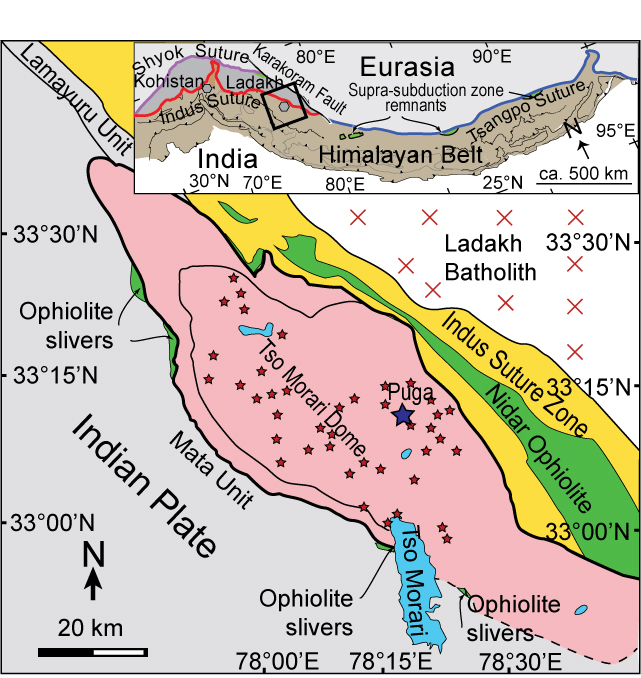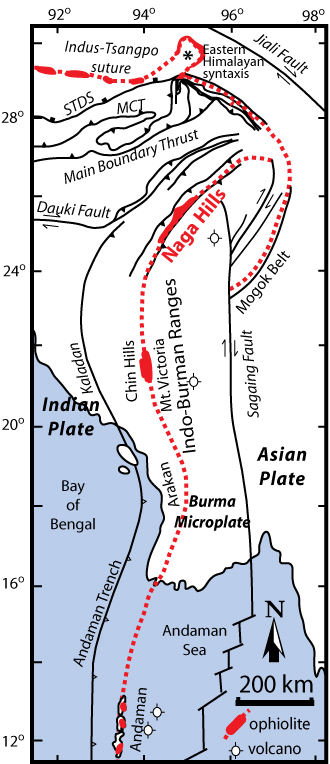Tso Morari eclogite, northwestern Himalayas
 The Tso Morari dome consisting of exhumed Indian continental crust is exposed in the northwestern Himalayas between the Indus suture zone to the northeast and the Zanskar Tethys Himalaya to the southwest. Exhumation of the dome is related to the subduction of the northern continental margin of India during its early Eocene collision with the Kohistan-Ladakh arc. It is demarcated by the northeast dipping Zildat shear zone that separates it from the low-grade metamorphic rocks of the Indus suture zone and the Early Cretaceous Nidar ophiolite in the northeast, and the south dipping Karzog shear zone that separates it from the Mata-Karzog unit and the Karzog ophiolite at its southwestern margin. The core of the dome consists of Cambro-Ordovian
felsic orthogneiss and metasediments intercalated with thick boudins of eclogite, structurally overlain by Lower Carboniferous-Triassic marine dolomitic marbles and metapelites. Coesite inclusions with
prominent radial fractures in their host garnet in eclogite indicate ultrahigh-pressure (UHP) conditions of metamorphism. Thermobarometry and P-T-MCO2 pseudosection modeling in the KNCaFMASTHCO system indicates that the eclogites were strongly heated at high pressures from 400-425 oC at 2.2-2.3 GPa to 670-720 oC at 1.8-1.9 GPa during the early stages of exhumation that was followed by decompression to ~0.4 GPa/450 oC. Diffusion modeling of Ca variation across the core-rim interface of garnet indicates that the heating stage lasted only <0.1 Myr, in accordance with geochronological constraints and fast exhumation rates. A comparison with global models of P-T paths in subduction zones shows that the intermediate P-T conditions of 1.8-1.9 GPa/670-720 oC of the Tso Morari eclogite are not achieved along a subducting slab. Instead, the intermediate P-T conditions are consistent with heating within the mantle wedge overlying the subducting slab. Therefore, the Tso Morari eclogites were possibly exhumed as part of a low-density, felsic diapir rising through the mantle wedge. Based on low viscosity values of mantle wedges associated with modern subduction zones, the calculated exhumation rate for the Tso Morari eclogite is extremely fast (29-147 mm/yr) and at par with that constrained for other northwestern Himalayan UHP rocks.
The Tso Morari dome consisting of exhumed Indian continental crust is exposed in the northwestern Himalayas between the Indus suture zone to the northeast and the Zanskar Tethys Himalaya to the southwest. Exhumation of the dome is related to the subduction of the northern continental margin of India during its early Eocene collision with the Kohistan-Ladakh arc. It is demarcated by the northeast dipping Zildat shear zone that separates it from the low-grade metamorphic rocks of the Indus suture zone and the Early Cretaceous Nidar ophiolite in the northeast, and the south dipping Karzog shear zone that separates it from the Mata-Karzog unit and the Karzog ophiolite at its southwestern margin. The core of the dome consists of Cambro-Ordovian
felsic orthogneiss and metasediments intercalated with thick boudins of eclogite, structurally overlain by Lower Carboniferous-Triassic marine dolomitic marbles and metapelites. Coesite inclusions with
prominent radial fractures in their host garnet in eclogite indicate ultrahigh-pressure (UHP) conditions of metamorphism. Thermobarometry and P-T-MCO2 pseudosection modeling in the KNCaFMASTHCO system indicates that the eclogites were strongly heated at high pressures from 400-425 oC at 2.2-2.3 GPa to 670-720 oC at 1.8-1.9 GPa during the early stages of exhumation that was followed by decompression to ~0.4 GPa/450 oC. Diffusion modeling of Ca variation across the core-rim interface of garnet indicates that the heating stage lasted only <0.1 Myr, in accordance with geochronological constraints and fast exhumation rates. A comparison with global models of P-T paths in subduction zones shows that the intermediate P-T conditions of 1.8-1.9 GPa/670-720 oC of the Tso Morari eclogite are not achieved along a subducting slab. Instead, the intermediate P-T conditions are consistent with heating within the mantle wedge overlying the subducting slab. Therefore, the Tso Morari eclogites were possibly exhumed as part of a low-density, felsic diapir rising through the mantle wedge. Based on low viscosity values of mantle wedges associated with modern subduction zones, the calculated exhumation rate for the Tso Morari eclogite is extremely fast (29-147 mm/yr) and at par with that constrained for other northwestern Himalayan UHP rocks.
Naga Hills Ophiolite, India-Myanmar collision zone
 The India-Myanmar collision zone is characterized by the eastward subduction of the Indian plate below the Burma microplate between the Early Cretaceous and Early Paleogene. It is a continuation of the Indus-Yarlung-Tsangpo suture of the Himalayas that swerves southward at the eastern Himalayan syntaxis and is offset northward by the north-south oriented dextral strike-slip Sagaing fault that defines the eastern boundary of the Burma microplate. The collision zone extends from the region north of Naga Hills to the Andaman-Nicobar Islands in Bay of Bengal, and consists of accretionary wedge sediments and ophiolite. The Naga Hills Ophiolite (NHO) is composed of dismembered bodies of serpentinized peridotite tectonite, layered mafic-ultramafics, mafic volcanics, pyroclastics, oceanic sediments, and high-pressure metamorphites such as glaucophane-bearing metabasics and cherts. It has an east-dipping thrust contact with the Disang Flysch in the west, and is overthrust from the east by the Naga Metamorphics of continental origin. The mafic-ultramafic units of NHO host tectonic slices and lenses of eclogite, garnet-blueschist, glaucophanite and greenschist from core to margin. Thermobarometry and P-T pseudosection analysis shows that the eclogites followed a clockwise P-T path with a prograde conditions between ~1.3 GPa/525 oC and 1.7-2.0 GPa/580-610 oC followed by retrogression to ~1.1 GPa/540 oC. A comparison with numerical thermal models of plate subduction indicates that the eclogites probably formed near the top of the subducting crust with convergence rates of approximately 55-100 km/Myr, consistent with high pre-collision convergence rates between India and Eurasia.
The India-Myanmar collision zone is characterized by the eastward subduction of the Indian plate below the Burma microplate between the Early Cretaceous and Early Paleogene. It is a continuation of the Indus-Yarlung-Tsangpo suture of the Himalayas that swerves southward at the eastern Himalayan syntaxis and is offset northward by the north-south oriented dextral strike-slip Sagaing fault that defines the eastern boundary of the Burma microplate. The collision zone extends from the region north of Naga Hills to the Andaman-Nicobar Islands in Bay of Bengal, and consists of accretionary wedge sediments and ophiolite. The Naga Hills Ophiolite (NHO) is composed of dismembered bodies of serpentinized peridotite tectonite, layered mafic-ultramafics, mafic volcanics, pyroclastics, oceanic sediments, and high-pressure metamorphites such as glaucophane-bearing metabasics and cherts. It has an east-dipping thrust contact with the Disang Flysch in the west, and is overthrust from the east by the Naga Metamorphics of continental origin. The mafic-ultramafic units of NHO host tectonic slices and lenses of eclogite, garnet-blueschist, glaucophanite and greenschist from core to margin. Thermobarometry and P-T pseudosection analysis shows that the eclogites followed a clockwise P-T path with a prograde conditions between ~1.3 GPa/525 oC and 1.7-2.0 GPa/580-610 oC followed by retrogression to ~1.1 GPa/540 oC. A comparison with numerical thermal models of plate subduction indicates that the eclogites probably formed near the top of the subducting crust with convergence rates of approximately 55-100 km/Myr, consistent with high pre-collision convergence rates between India and Eurasia.
The peak pressure of metamorphism of the Naga Hills eclogite is higher than that of the Cretaceous Sapi-Shergol blueschists of the Indus suture zone (0.9-1.0 GPa) in northwestern Himalaya. Hence, the depth of subduction may have been greater at the eastern margin than at the northern margin of the Indian plate prior to the India-Eurasia collision. However, the UHP conditions of the Tso Morari eclogites indicates that the Indian continental subduction under Eurasia was deeper in Eocene.





